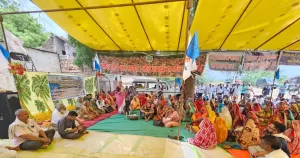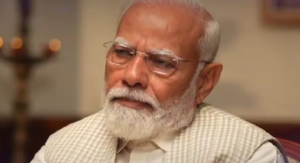Two shocking revelations have hit recently: Vedanta-Foxconn cornering an entire sectoral subsidy of Rs 76,000 crore to build chips and a wrong Hyundai group getting the PLI to make EV batteries.
The superficial and partisan debate over “freebies” sparked by Prime Minister Narendra Modi himself now stands exposed more than ever, in multiple ways.
For one, the Union Cabinet led by him extended “free” ration to 62.5% of households – over and above “subsidized” ration to the very same population – by another three months to December 31, 2022. Not just the festival season, but more importantly, the Gujarat and Himachal Pradesh elections are coming. So, the Union Cabinet ignored the Finance Ministry’s objections to such an extension the previous day.
The ministry was opposed on two grounds: (i) the additional fiscal outgo of Rs 44,762 crore would add to fiscal stress caused by the war in Europe and the rise in fuel and other commodity prices and (ii) given that the pandemic, which sparked the “free” ration scheme in April 2020, has subsided considerably, there is little justification for an extension.
It is pertinent here to recall the role the “free” ration had played in the BJP’s victory in four of ffive states earlier this year – Uttar Pradesh, Uttarakhand, Goa and Manipur – despite strong anti-incumbency against the party.
Both the Lokniti-CDSC and Axis-My India had found in their surveys that the BJP owed its victory significantly to a new voters’ bloc it had built around the Modi government’s welfare schemes, called the “labharthi varg”, to win votes.
When the Prime Minister started the “freebie” debate, he denounced welfare schemes of state government as “revdi culture” to win votes. That was in July this year, just around the time he started campaigning for the Gujarat election.
The obvious target was the Aam Admi Party (AAP), the main challenger in Gujarat, which is known for giving free electricity and water in Delhi and Punjab. But the Prime Minister skipped his own freebies – “free” ration, PM-Kisan, subsidized LPG connections etc. and also, numerous freebies to industry (corporate tax cut, corporate loan write-offs and other tax and fiscal subsidies).
His “freebie” debate led the Supreme Court to urgently hear a PIL on it, filed earlier by BJP member Ashwini Upadhyaya, for nearly half of August. The then Chief Justice of India Justice N.V. Ramana himself heard it virtually daily till his retirement day, but there was no result. The court left the matter for a future three-judge bench to take forward.
Two recent instances throw up how mindless Modi government’s freebies for the industry can be (apart from being generous).
A week after Maharashtra Chief Minister Eknath Shinde lamented (September 14) that despite offering Rs 39,000 crore “subsidy” the Vedanta’s semiconductor venture Vedanta-Foxconn shifted to Gujarat (Gujaratis going to poll soon), the Union Cabinet “modified” fiscal subsidy for the semiconductor sector by offering a uniform “50% incentives” on “project cost” and “capital cost” covering the entire gamut of sectoral activities on September 21.
With a 50% subsidy, the Foxconn-Vedanta will corner the entire Rs 76,000 crore subsidy allotted for the semiconductor sector – it being a $20 billion venture and a 50% subsidy would mean $10 billion – more than Rs 76,000 crore or $9.5 billion (at Rs 80). There would be no other player or competitor in the sector, allowing monopoly control to Vedanta.
There are other “freebies” too. Like, the production-linked incentive (PLI) scheme. It offers subsidies of 1% to 20% in 14 sectors to promote “Make in India”. The 2021 budget allocated Rs 1.97 lakh crore for 13 sectors and later, Rs 120 crore was added for drones (14h sector). Many projects have been cleared under it, but there is no knowing how the freebies are being used because there is simply no mechanism to track and monitor their progress.
Here too the same mindless exercise is evident.
In March 2022, the Centre awarded PLIs (freebie) of Rs 18,000 crore to four companies to make EV batteries, one of which was Hyundai Global Motors Company Limited (HGMCL). In mid-July, the South Korean major Hyundai Motor Company (HMC) issued a public statement saying that the HGMCL had nothing to do with it (not an affiliate, subsidiary or group company). On August 29, this wrong Hyundai withdrew from the PLI and the Centre said it was re-examining how the goof-up happened and would find a new one to replace it.
There is actually a pattern to such mindless acts.
Earlier this year, the Centre cancelled two privatization deals – another freebie to private businesses as such deals are known to be at throwaway prices – Central Electronics Limited (CEL) and Pawan Hans Limited (PHL).
The cancellations came after (i) the employees of the prized PSUs protested against cheap valuations and (ii) investigative reports revealed that the CEL was sold to a furniture and furnishing firm run by BJP leaders and the PHL to a defaulting tax haven-based finance company.
How do such deals go through in the first place? What motivates such deals? The answers to these questions carry the secrets to the Centre’s love for “revdi culture”.
(Courtesy: Centre for Financial Accountability (CFA). CFA engages in critical analysis, monitoring and critique of the role of financial institutions – national and international, and their impact on development, human rights and the environment, amongst other areas.)




